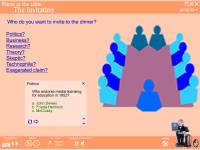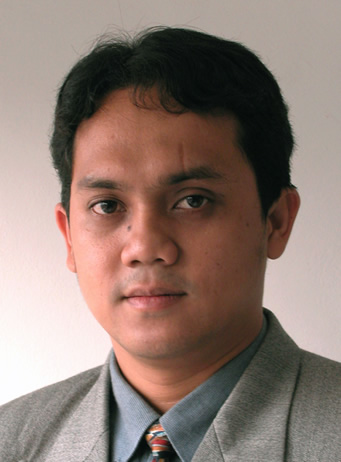Television is the best technology for delivering messages. It can transfer sound and moving pictures into its viewer’s mind almost instantly. The logic then, this medium must be good for learning purposes. Television is so powerful that, in the advent of television in the mid-1960s, Marshall McLuhan correctly described television as the message when he said “the medium is the message” (1967). Television as an entertainment medium has been proved, but television as an educational tool has not. Nevertheless, according to the Jakarta Post on Oct 13, 2004, Indonesia is launching a government educational television broadcast which is called Televisi Edukasi (TVE).
This breakthrough is an antithesis of today’s condition. We are having a lot of junk material in our television screen, for example. So, TVE perceived as the right thing to do. However, it is worthy to asking: Is it truly the right course of action to answer the challenge of Indonesian today’s media situation? What is the real challenge that an educational television is facing in the future. This article is trying to explain the challenge in the future based on historical pattern.
Should we have another state-run TV station, when TVRI is on the brinks of bankruptcy (The Jakarta Post, December 29, 2003)? This situation shall not be a hindrance of doing a good deed in Indonesian Educational Media and Technology history. However, this is a sign that building another state-run educational television must be taken into consideration seriously. For sure TVE does not want to be written in the history in the same class with the Televisi Pendidikan Indonesia (TPI) as failure.
TVE will be operated by PUSTEKKOM (Kompas, October 13, 2004). After being left behind by TPI, PUSTEKKOM was left with a lot of educational TV programs that PUSTEKKOM produced for TPI on subcontract basis. I believe one of the reasons TVE is launched is because TVE can take the advantages of these abundance material and millions-of-dollar idle equipments. However, relying on old paradigm; such as advertisement and production house business model; or just merely making a good use of idle resources may lead TVE to the same bitterness of failure. The stake is especially high for TVE to operate an educational television that is aiming to educational institution market such as universities and schools because The University of Indonesia is also planning to build an educational television station. This television broadcast, which will be called TVUI, is aiming from the same market.
So let us see what happened to TPI. TPI was founded in January 1991. It was aiming for educational institution such as formal schools; and distance learning audience from the Universitas Terbuka (UT – Indonesian Open Learning University). TPI was supported by many institutions in the same field such UT, PUSTEKKOM (Pusat Teknologi Komunikasi dan Informasi Pendidikan – Center for Educational Information, Communication and Technology) and SEAMEO SEAMOLEC (South East Asia Ministers of Education Organization – Open Learning Center) in developing the content and technology. TPI was struggling for several years before it finally changed its course of action to pursue commercial objectives and leaving its allies behind.
According to Paul Saettler, educators have struggled for recognition to secure the channels for educational broadcasting. Frieda Hennock was the first person who was able to force the government to issue 10% of the broadcast license for education in 1952. She was succeeded because she was also supported by educators who were willing to testify for her. The US government continued to support the educational television movement through National Defense Act 1958. The first direct aided fund was signed by President John F. Kennedy in the Communication Act in 1962.
The first non-experimental Educational Television was founded in Iowa State University as early as 1954, however, in 1952; there was an urge demand for an educational television network which was proposed by the Penn State College (now University). The first educational network was developed in Alabama and succeeded in raising standard of instruction throughout the state. Due to the raising needs of distribution and suitable programs, Public Broadcast Service (PBS) was built in 1967. PBS does not produce any programs; it interconnects several major production centers.
Several successes followed in the following years have led the governor of American Samoa, H. Rex Lee, to build an Instructional Television Station in 1964. Many teachers were sent to American Samoa to become TV Tutors. Of all huge investment made for this effort, American Samoa Instructional Television failed because it did not listen to the history and previous research projects on instructional television.
What can we learn from above information? First of all that what happened to TPI was historical De Ja Vue. It is similar to what happened to American Samoa. Further more, Saettler mentions that many University TVs have been reported stagnancy in their effort to maintain sustainability. TVE (and TVUI too) may be doomed to repeat the same mistake as pointed out in American Public broadcast history. Surprisingly that TV tutor model has been around for long and it also the reason of failure for the American Samoa Instructional Television. So what works then? Throughout his book, Saettler mentions that many educational technology’s failures were caused by focusing more on the product rather than process. Especially in American Samoa case, the television program was not followed up by in class activities.
John Dewey, said that, learning process must allow learners to discover and construct knowledge. Indonesian students have shown their capability in doing so. In recent independent educational television project in July 2004, several SMUN70 students created a fifteen minutes educational video on Osteoporosis. It is reported that they learnt better about the subject by doing this project.
To create process in adopting television in the classroom requires bigger support from the government to include it in the curriculum. Government support is not the only key success factor, as we can also learn from American history that the movement was initiated from the educators, we need more educators’ initiative because in order to make TVE’s efforts come to a full cycle. Television is a powerful medium as McLuhan noted, making it full cycle in the hands of the right people will enhance its impact.















.1.jpg)


